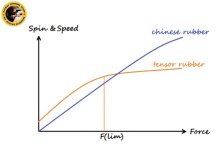Hi all. Thanks for responding, even if you aren't a fan of the graph. I have learnt so much from reading your posts on this forum, going back years.
The goal of this graph is not to provide a factual representation, I hope I make that clear. Perhaps I shouldn't have added H3 old by name, that line was just meant for a general exponential type rubber.
So what is my idea?
The internet is full of words describing rubbers, not based on data points either ('slow', 'activates', 'springy', 'bottoms out'). My idea is to have a graph to visualise those words somewhat more. Have a few curves in there that roughly describe the most common rubbers, so that communication becomes easier.
Perfection isn't necessary, it's to give a general gist.
As an example: if someone plays with a very soft tensor rubber and asks for a 'upgrade', you could help that person by pointing out that it has a limited max speed, and point to better alternatives. A picture says more than a 1000 words.
With actual data it could possibly be an actual graph, but as mentioned, many variables would need to be fixed, stroke type and blade being big ones. Not to mention that it is for only one relevant dimension, but doesn't say anything about another inportant parameter: spin, which is also nonlinear in many ways. So a lot of work for a not so big reward.
Just to point out, I am a mechanical engineer as well. I have studied car and motorcycle tires and I am reasonably familiar with the nonlinear behaviors of at least those rubber surfaces, plus tire construction which has little to do with rubber. It seems very comparable to the table tennis rubber+blade combo.
I was debating of making a physical model of tt rubbers + blades out of hobby (I like modelling stuff), and this is for me a part of the preparation. Its good to have a better general understanding before starting research. So this was for myself but I figured it might be useful for the community as well. I know at least Blahness has once mentioned the nonlinearity in different directions, and this was a hot topic on this forum once (yes, I really have read a lot...). But other than that I couldn't really find much on the subject. Some scientific papers that were good.
I like solving hard nonlinear puzzles. But even though I do have in theory enough to go on, high fps camera, access to a ball robot, and some good analysis tools, but I think the complexity here is incredibly large. Also I contacted some people who actually do have large amounts of data on blades, wether they'd be interested in cooperating for such a model, and they weren't. So it stays an idea for now.
So in short, if you think the visual is helpful, but could be better, then I'd love to hear your input and I'll edit it to make it better. If you all think it isn't helpful or even detrimental, I'll keep it to myself, no problem.
















